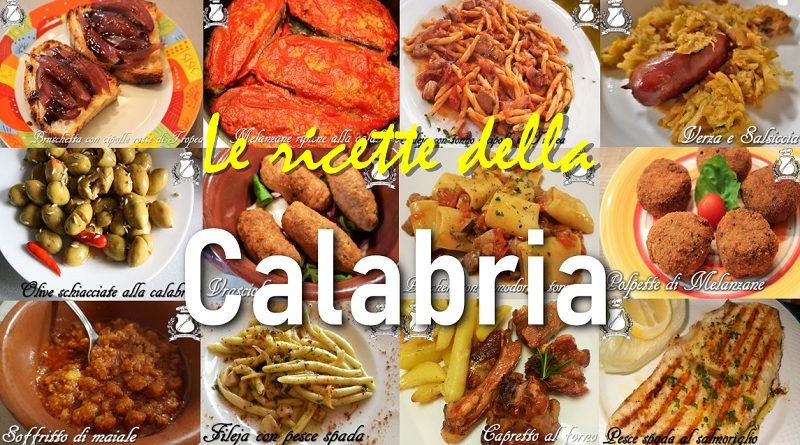
The Traditional Recipes of Calabria

Typical recipes of Calabria
Calabria is a harsh and picturesque land, whose population still lives tenaciously linked to frugal traditions, to their houses and their gardens where they spend most of their time. This aspect is also found in Calabrian cuisine, an essential cuisine that exploits the precious gifts of this fertile and generous land: olive trees, citrus fruits, figs, vegetables such as aubergines and peppers and vineyards perched on the slopes of the mountains. Calabrian cuisine shares many characteristics with other southern regions, such as the abundant use of olive oil and vegetables and homemade pasta dishes in the most varied ways.

Among the formats of homemade pasta from Calabria, we find the “maccarruni cu fierru”, or “fileja”, a format of long pasta obtained by twisting it around an iron stick, or the “capiddi d’angilu”, or angel hair , very thin noodles. The toppings are often based on tomato sauce with the addition of garlic, eggs, sliced meat and pecorino cheese, as in the “maccaruni a lu furnu”. But there are also simpler and much less laborious pasta dishes such as spaghetti with garlic and oil where the red and spicy chilli pepper (also called pipi vruscente, pipazzu, pipariellu) finds its place, another symbolic product of Calabria.

Today as then, the slaughter of the pig is an important event for the local people, always followed by a sumptuous banquet in which only invited people take part. The preparation of the “frittule” is of exceptional importance: feet, rinds, head, bacon and all the other fatty parts are cooked over a slow wood fire in a large copper boiler. The heat turns the fat into lard. The fleshy residues known in the north as ciccioli, here called frittule or frisuli or frisulimiti, are extracted with a perforated spoon and served together with pickled aubergines and orange salads (note the intelligence of the side dishes, capable, due to their acidity, of counteracting excess fat). No part of the pig remains unused, following the slaughtering the different parts of the pig are used to produce capocolli, salted and smoked hams, including the very famous and typical “n’duje” or “ndugghie”, spicy sausages to which a lot of chilli..

Another typical Calabrian dish based on pork is “murzeddhu”, or morzello, a sauce made from lung, liver, heart, spleen, tripe and tomato sauce. Tradition would like it consumed in the early hours of the morning. In this regard, a proverb from Cosenza says: “Who eats de bon’ura ccu nu pugnu scascia nu muru”, (whoever eats early with a fist breaks a wall), while in Catanzaro it is often said: “Whoever lives ahead ‘u suli fort buy and minda culuri” (those who drink before the sun rises fort buy and add color). The murseddu was prepared by the innkeeper at dawn, by rinsing the offal and then cutting it into strips and then slowly frying it in a large pot. Red wine, peeled tomatoes and the ever-present chili pepper were added. After an hour or more of cooking, it was finished with a generous amount of oregano, and then the murseddu was ready. No, it is not eaten in a bowl, but served interspersed in the “pitte”.

After the chilli pepper, the pride of Calabria falls on the aubergines. Where does this privilege come from? The aubergine has found congenial climate and soil conditions in this region, and therefore provides highly delicious products. Drought, high average temperatures, siliceous soils with very little lime force the plant to stunted growth and, by depriving the species of the possibility of accumulation phenomena occurring in the internal tissue, allow the ripening of a whole complex of aromatic substances in the fruit , mostly esters, which give particular flavors to the pulp and allow, always within certain limits, the development of aromas during the cooking process.

Hence the reason for the many ways in which aubergines are offered: fried, roasted, stuffed, with mushrooms, in oil, sweet and sour, in parmigiana, scapece, alla reggitana, alla finitese, where they are floured and fried after being mixed with cheese , pepper and basil, alla cariatese, where they are filled with bread, anchovies, olive pulp and garlic, alla rotese, where they are cooked with garlic and mint, alla rossanese, where they are instead boiled and then seasoned with vinegar, garlic, pepper and basil, meatballs, ciambotta and in many other ways.
But Calabria does not only have land products, its coasts are very many, and it is almost completely surrounded by the sea. So even fish strongly become part of that already vast assortment of products to be used in the kitchen. Swordfish and fresh tuna are in fact the kings of the local cuisine, but other fish also form part of the culinary tradition, as well as dried fish from northern Europe such as the “stocco” which in Reggio Calabria and in the Locride in general we find as Stocco alla Mammolese.
First Courses

Fileja with tuna and Tropea onions
Fileja con tonno e cipolle di Tropea
